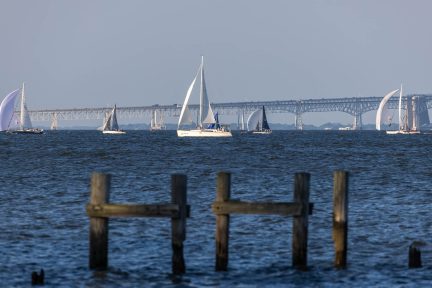2017 Blue Crab Advisory Report released
In a report released today, the Chesapeake Bay Program encouraged the jurisdictions that manage the Bay’s blue crab fisheries to maintain a risk-averse approach as they set regulations in 2017.
In a report released today, the Chesapeake Bay Program encouraged the jurisdictions that manage the Bay’s blue crab fisheries to maintain a risk-averse approach as they set regulations in 2017. The report confirmed that while the 2017 estimated population of adult female blue crabs in the Chesapeake Bay was higher than the target, the overall population of blue crabs declined. The annual Blue Crab Advisory Report, developed by the Chesapeake Bay Stock Assessment Committee and approved by the Chesapeake Bay Program’s Sustainable Fisheries Goal Implementation Team, provides Bay resource managers with scientific data and advice to inform their decisions regarding blue crab fishing regulations.
“The annual Blue Crab Advisory Report provides valuable data analysis and recommendations to the agencies that manage crabs here in the Bay to help them make scientifically informed decisions regarding our beloved—and valuable—blue crabs,” said Sean Corson, acting director of the National Oceanic and Atmospheric Association Chesapeake Bay Office and Sustainable Fisheries Goal Implementation Team Chair. “The science it features enables us to enjoy crabs at crab feasts and on our dinner tables, today and in future years.”
The Blue Crab Advisory Report includes expert analyses of data from the annual Bay-wide Winter Dredge Survey, released earlier this year, as well as harvest estimates from recent years. According to the Blue Crab Advisory Report and the scientific reference points that resource managers follow for “target” levels—which are considered healthy—and “threshold” levels, which mark the border between healthy and unhealthy levels, the Chesapeake Bay blue crab stock is currently not depleted and overfishing is not occurring.
The estimated 2017 population of 254 million adult females was higher than the target of 215 million set by the Chesapeake Bay Watershed Agreement. In 2016, 16 percent of all female crabs were harvested—below both the target (25.5 percent) and threshold (34 percent) levels. The report indicates that while numbers of adult female crabs in the Bay increased by 30 percent in 2017, the overall crab population decreased by almost 18 percent from 553 million in 2016 to 455 million in 2017. Notably, the number of juvenile crabs decreased by 54 percent from 2016 to 2017.
“The highly variable nature of blue crabs was on full display this past year,” said Glenn Davis, Chair, Chesapeake Bay Stock Assessment Committee and Maryland Department of Natural Resources. “The largest abundance of spawning females from the Winter Dredge Survey time series was great news, and demonstrated what can happen when jurisdictions adhere to science-based management. The low recruitment served as a reminder that large inter-annual fluctuations can be part of the norm and that managing blue crabs is a continuous challenge.”
During the 2016 crabbing season, approximately 60 million pounds of blue crabs were harvested from the Bay and its tributaries by commercial fishermen—roughly 20 percent more than in 2015. Recreational crabbers harvested just over four million pounds.
The Blue Crab Advisory Report recommends:
- Jurisdictions should maintain a cautious, risk-averse approach in 2017, and consider scaling back the fall fishery from last year’s more liberal regulations. This would protect a greater number of juvenile crabs and give them the opportunity to grow old enough to spawn next year, which would produce more crabs in the future.
- The accuracy and quality of tracking both commercial and recreational harvests should continue to be improved. Current efforts to collaborate with industry groups on electronic and online reporting systems and other new reporting technologies should continue.
- Jurisdictions and scientists should work to address specific research questions and discuss timing, rationale and resources for future stock assessments that would provide in-depth analysis of the blue crab population, fishery and management.
Blue crab populations can naturally vary widely from year to year, based on weather, water temperature and other conditions, as well as fishing pressure. The Chesapeake Bay Program’s Sustainable Fisheries Goal Implementation Team is funding research evaluating ecosystem effects on the blue crab population to enable
more accurate quantification of these effects in the future. Commercial fishermen rely on a steady supply of crabs in the Bay, and recreational crabbers enjoy being able to catch crabs. Using science such as that included in the Blue Crab Advisory Report enables resource managers to set regulations that help support a sustainable blue crab population and promote coordination across the jurisdictions.
The blue crab fishery in the Chesapeake Bay is managed by the Maryland Department of Natural Resources, Virginia Marine Resources Commission and Potomac River Fisheries Commission.
This multiagency report supports the blue crab abundance and blue crab management outcomes outlined in the Chesapeake Bay Watershed Agreement, which seeks to maintain a sustainable blue crab population, supporting healthy commercial and recreational harvest. Development of the Blue Crab Advisory Report is made possible through the efforts of experts from state and federal agencies and academic institutions who serve on the Chesapeake Bay Stock Assessment Committee.



